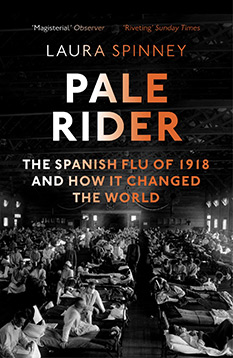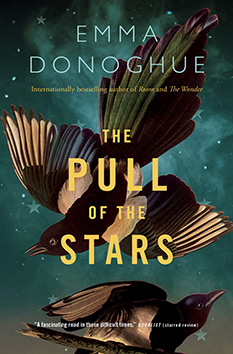Pale Rider: The Spanish Flu of 1918 and How it Changed the World, Laura Spinney (London: Vintage, 2017)
The Pull of the Stars, Emma Donoghue (Toronto: HarperCollins, 2020)

Published in 2017, Laura Spinney’s historical investigation of the 1918 pandemic could not have anticipated what was to follow in three years. And yet Spinney notes that a 2016 report of the Commission on Creating a Global Health Risk Framework for the Future (GHRF) estimated a 20% likelihood that there would four or more pandemics in the next one hundred years. While Spinney could not have anticipated the emergence of Covid-19 in its precise details, a new global pandemic was foreseeable. The distinction between anticipated and foreseeable is perhaps one of precision. In retrospect, Spinney comes off as a Cassandra figure, declaring the obvious but doomed to go unheard.
The obvious is easy enough to state: in 1918 we went through a horrible global event; it’s highly likely that we’ll go through it, or something like it, again; so we need to use our experience to give us an advantage in addressing what we know is coming. Sitting on what I presume is the tail end of the Covid-19 pandemic, it feels too late to take Spinney’s message to heart, but only as it concerns the Covid-19 pandemic. There’s no reason why we can’t take her message, graft it to contemporary lessons, and punt the whole thing down the line so we’re better prepared to meet the inevitable next go-around.
Spinney’s message rests on the idea that we are capable of nurturing our shared memory. However, like individual memory, our shared repository of teachings is selective. She notes that WorldCat lists approximately 80,000 titles in 40 languages on World War I but only 400 titles in 5 languages on the Spanish Flu notwithstanding the fact that, of the two contemporaneous events, the Spanish Flu was by far the more deadly. It’s difficult to nail down precisely why the discrepancy in what we choose to memorialize. Like a pandemic, we may not be able to assign a definitive reason for this, resorting instead to the language of epidemiology which expresses reasons as probabilities and shuns definitive statements.
One possibility is that armed conflict conforms to a simple narrative with readily identifiable causes (the enemy is to blame) and a well defined conclusion (we won; they lost). Pandemics, on the other hand, arise in a cloud of mystery and, once they’ve run their course, fizzle away before humans can claim any sort of victory over the tiny foe. The ready-made narrative arc we find in armed conflict lends itself to our dominant cultural forms, epic poems, novels, movies, video games, allowing us to repeat the story again and again until it becomes an embedded cultural memory. Meanwhile our memory of a pandemic, like the pathogen itself, fizzles away before we can assign it any cultural heft.
I came to Spinney via the CBC Ideas podcast, Pandemic Amnesia, which solicits her views. The podcast also offers the distinction between communicative and cultural memories developed by Egyptologist Jan Assmann. Communicative memories are those which we share through interpersonal contact (e.g. a grandmother going through a photo album with a grandchild and telling stories as she turns the pages). Its time horizon is limited to 3 or 4 generations or about 80 years. Cultural memories are those which we transfer to cultural artifacts or narrative forms and which we periodically reanimate when, for example, we reenact rituals or mount plays. Its time horizon is much longer, potentially embodying a mythical past complete with origin stories.
Memory enlists time in the task of identity formation. It’s not something we do privately inside our heads, but has a social dimension. This last observation represents a shift from the earlier psychoanalytic work of Freud and Jung who located shared memory within the dynamics of our unconscious lives. In a curious twist, Assmann also claims that, insofar as it is necessary to identity formation, memory requires acts of forgetting. I’m not entirely sure what he means by this, but I suspect he means we prune our memories to rid them of inconvenient complexities; we can’t allow our shared narratives to get tangled up in the details. For example, we like to say that World War I began because Gavrilo Princip assassinated Archduke Franz Ferdinand. This is easier than investigating territorial disputes, economic conditions, and the rise of nationalism throughout Europe.
Applying Assmann’s framework to the discrepancy between the memory of armed conflict and the memory of a global health crisis, it is possible that the people of 1918 addressed the Spanish Flu predominantly through communicative memory, and the war through cultural memory. These distinct modes are not absolute. There are important cultural traces of the Spanish Flu that persist to this day, just as there is much of World War I that now lies beyond our reach. But viewed in broad strokes, this account seems plausible.
Spinney suggests we take a longer view, arguing that, in terms of shared memory, the “Great” War and the Spanish Flu are on inverse trajectories. On a longer horizon, with a view that stretches back 500 or 700 years, Spinney observes that the Black Death, which ravaged Europe for centuries beginning in the mid-1340’s, is the one global pandemic everybody has heard of (until the rise of Covid-19). Like the Spanish Flu, the Black Death happened against the backdrop of armed conflict. However, the same people who have heard of the Black Death would be hard pressed to name that armed conflict. In fact, the Black Death didn’t even acquire its name until the 16th century; before then, it had been known as the Blue Death. In other words, even two centuries after its emergence, history’s most devastating pandemic was still solidifying its place as a shared memory. On Spinney’s longer temporal horizon, we can expect that the 20th century’s so-called world wars will fade from our shared memory. There will come a time, sooner than we might think, when these wars will get barely a mention in high school history texts. At the same time, interest in the Spanish Flu is gathering steam, shifting from a matter of academic interest debated amongst specialists to a matter of cultural concern that is only now beginning to reveal its social meanings.

Enter Emma Donoghue, whose novel, The Pull of the Stars, illustrates Spinney’s view that we’re still in the early days of developing a cultural memory of the Spanish Flu. The Pull of the Stars tells the story of a young Dubliner named Julia Power, a nurse who lives with her mute brother, Tim (a victim of what we would now call war-induced PTSD). Julia works in a makeshift maternity ward for women who have contracted the Spanish Flu while pregnant. This is set against a factual backdrop. Her supervising doctor is the historical figure, Kathleen Lynn, who in 1918 was Sinn Fein’s director of public health and who gets a mention in Laura Spinney’s book. These are the early days of the suffrage movement, when the sentiments against a woman practising medicine and holding a position of authority are overwhelming. Alongside Julia, we witness the near-barbarism of a male-dominated obstetrics practice that is resistant to new techniques aimed at improving the odds of survival for both mother and child. Alongside Julia, we witness the gross injustices inflicted by religious orders who have, since time immemorial, inserted themselves into the management of women’s health and, because they do it so badly, the management of orphanages (which they run with as much cruelty in Ireland as residential schools in Canada). As with Covid-19, so with the Spanish Flu: a major pandemic exposes social injustices that have always been there but, until the emergence of a major public health crisis, have been easy to deny.
If an alternate Emma Donoghue had tried to write this novel 50 years earlier, she couldn’t have done it. Only with the benefit of a hundred years do we realize how disruptive the Spanish Flu was, driving suffrage, the socialized delivery of health care, and a drift to secular life that continues to this day. Only today can we begin to inscribe those disruptions into our cultural memory by revisiting earlier events and acknowledging, for example, the gendered dimensions of both oppression and suffering that played out in those times. I expect the emergence of Covid-19 will accelerate this trend as we leverage the Spanish Flu as a proxy for talking about things in today’s world that are still too raw.
A measured examination of the Spanish Flu, and the recognition that its consequences unfold on a time horizon greater than the span of a single lifetime, is cause for hope as we think about Covid-19. For most people today, our current situation is fraught with frustrations around issues of access to health care including emotional and psychological care, income support for the sick and for those whose means of support has evaporated, the perceived failure of medical science to protect us, the politicization of public health institutions, supply chain disruption, the interruption or loss of education, the failure of international institutions to coordinate responses, and lack of social cohesion. And yet, as we have learned from the Spanish Flu, these sites of frustration can give impetus to meaningful and enduring change. In fact, such change may already be working its way into our lives. We can’t see it because, like a short-sighted person staring at an impressionist painting, we’re too close to the subject. But with the benefit of time, and through the mechanisms of communicative and cultural memory formation, we will wake up one morning and recognize that we live in a better world.
Image Credit: Camp Funston, at Fort Riley, Kansas, during the 1918 Spanish flu pandemic, public domain, Wikimedia Commons.
For more on the Black Death, see my post on Barbara Tuchman’s A Distant Mirror.
I am almost halfway through Pale Rider (having read this post when you first published it). Great book! Almost scary parallels with the Spanish flu and Covid-19 – masking questions, role of churches & their leaders, denials, vaccine hesitancy, etc. I wonder what the author thinks about this pandemic?
Hi Mary, thanks for visiting nouspique! I stumbled on Pale Rider while listening to the Nov 12 2021 CBC Ideas podcast on Pandemic Amnesia. It includes sound bytes from Laura Spinney made after the advent of Covid-19: https://www.cbc.ca/radio/ideas/why-do-we-commemorate-wars-but-not-pandemics-1.6246133